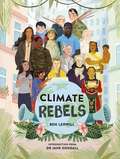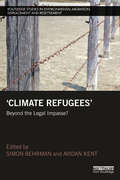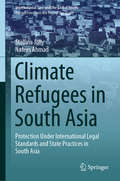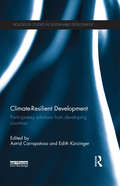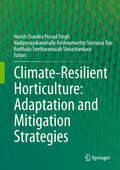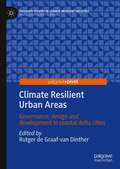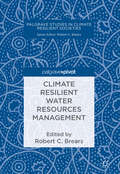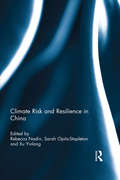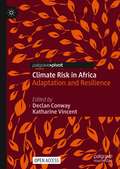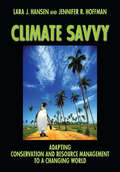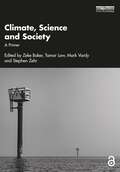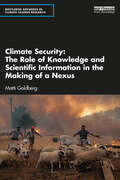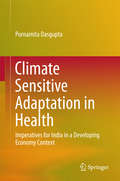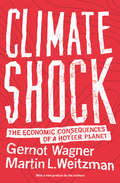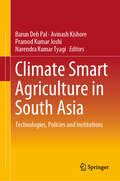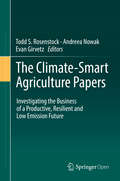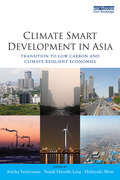- Table View
- List View
Climate Rebels
by Ben LerwillOn the outskirts of the Milky Way, floating slowly through space, there hangs a planet unlike any other. It has oceans, deserts, jungles and mountains. It has life that swims, life that soars and life that swings through the trees. It is a place of dazzling variety and infinite wonder - and it's the only world we've got. Climate change is happening, now. But it's not too late to change the story. Meet the humans, from around the world, who are fighting to save our planet. This is your call to arms. Featuring 25 hopeful stories including Greta Thunberg, David Attenborough, Jane Goodall, Wangari Maathai - as well as lesser-known heroes, such as turtle-protector Len Peters, the guardians of the Amazon rainforest, and the poacher patrollers The Black Mambas.This book will transport you from the poles, to the oceans, to the rainforests, with iconic illustration. These are true stories to make you think, make you cry, make you hope - and these are stories to make us all stand together and protect our home. These stories are the proof that one person's small changes can grow into something big, and powerful, and world-changing.So read on to be inspired, as we take our future in our own hands, and together save Planet Earth - for all the living things that call it their home.
Climate Refugees: Beyond the Legal Impasse? (Routledge Studies in Environmental Migration, Displacement and Resettlement)
by Simon Behrman Avidan KentCurrent estimates of the numbers of people who will be forced from their homes as a result of climate change by the middle of the century range from 50 to 200 million. Therefore, even the most optimistic projections envisage a crisis of migration that will dwarf any we have seen so far. And yet attempts to develop legal mechanisms to deal with this impending crisis have reached an impasse that shows little sign of being overcome. This is in spite of the rapidly growing academic study and policy development in the area of climate change generally. 'Climate Refugees': Beyond the Legal Impasse? addresses a fundamental gap in academic literature and policy making – namely the legal ‘no-man’s land’ in which the issue of climate refugees currently resides. Past proposals for the regulation of climate-induced migration are evaluated, inter alia by their original authors, and the volume also looks at current attempts to regulate climate-induced migration, including by officials from the International Organization for Migration (IOM), the office of the United Nations High Commissioner for Refugees (UNHCR) and the Platform on Displacement Disaster (PDD). Bringing together experts from a variety of academic fields, as well as officials from leading international organisations, this book will be of great interest to students and researchers of Environmental Law, Refugee Law, Human Rights Law, Environmental Studies and International Relations.
Climate Refugees: Beyond the Legal Impasse? (Routledge Studies in Environmental Migration, Displacement and Resettlement)
by Simon Behrman Avidan KentCurrent estimates of the numbers of people who will be forced from their homes as a result of climate change by the middle of the century range from 50 to 200 million. Therefore, even the most optimistic projections envisage a crisis of migration that will dwarf any we have seen so far. And yet attempts to develop legal mechanisms to deal with this impending crisis have reached an impasse that shows little sign of being overcome. This is in spite of the rapidly growing academic study and policy development in the area of climate change generally. 'Climate Refugees': Beyond the Legal Impasse? addresses a fundamental gap in academic literature and policy making – namely the legal ‘no-man’s land’ in which the issue of climate refugees currently resides. Past proposals for the regulation of climate-induced migration are evaluated, inter alia by their original authors, and the volume also looks at current attempts to regulate climate-induced migration, including by officials from the International Organization for Migration (IOM), the office of the United Nations High Commissioner for Refugees (UNHCR) and the Platform on Displacement Disaster (PDD). Bringing together experts from a variety of academic fields, as well as officials from leading international organisations, this book will be of great interest to students and researchers of Environmental Law, Refugee Law, Human Rights Law, Environmental Studies and International Relations.
Climate Refugees in South Asia: Protection Under International Legal Standards and State Practices in South Asia (International Law and the Global South)
by Stellina Jolly Nafees AhmadThis book addresses the forms of legal protection extended to people displaced due to the consequences of climate change, and who have either become refugees by crossing international borders or are climatically displaced persons (CDPs) in their own homelands. It explores the legal response of the South Asian Jurisdictions to these refugee-like situations, and also to what extent these people are protected under current international law. The book critically examines and assesses whether States have obligations to protect people displaced by climate change under international refugee law (IRL) and international climate change law (ICCL). It discusses the issue of climate migration in South Asia, analyzes the legal and judicial response initiated by South Asian nations, and also investigates the role of SAARC in relation to climate change and climate refugees. Drawing on the International Legal Standards and States’ Practices in South Asia regarding climate refugees, the book shows how IRL, ICCL, and IHRL (international human rights law) have been used to address and identify the gaps in the global legal protection framework concerning the contours of the normative debate on climate refugees, climate change displacement, migration, forced migration, susceptibility to climate change, typology of climate change-induced displacement, role of the SAARC and its municipal legal systems, approaches to climate change, human mobility and developing a hybrid regional law, or advocating a legal alternative of equal measure in a region characterized by diversity and multiculturalism. The book offers valuable takeaways for students, researchers, consultants, practitioners and policymakers alike.
Climate-Resilient Development: Participatory solutions from developing countries (Routledge Studies in Sustainable Development)
by Astrid Carrapatoso Edith KürzingerThe concept of resilience currently infuses policy debates and public discourse, and is promoted as a normative concept in climate policy making by governments, non-governmental organizations, and think-tanks. This book critically discusses climate-resilient development in the context of current deficiencies of multilateral climate management strategies and processes. It analyses innovative climate policy options at national, (inter-)regional, and local levels from a mainly Southern perspective, thus contributing to the topical debate on alternative climate governance and resilient development models. Case studies from Africa, Asia, and Latin America give a ground-level view of how ideas from resilience could be used to inform and guide more radical development and particularly how these ideas might help to rethink the notion of 'progress' in the light of environmental, social, economic, and cultural changes at multiple scales, from local to global. It integrates theory and practice with the aim of providing practical solutions to improve, complement, or, where necessary, reasonably bypass the UNFCCC process through a bottom-up approach which can effectively tap unused climate-resilient development potentials at the local, national, and regional levels. This innovative book gives students and researchers in environmental and development studies as well as policy makers and practitioners a valuable analysis of climate change mitigation and adaptation options in the absence of effective multilateral provisions.
Climate-Resilient Development: Participatory solutions from developing countries (Routledge Studies in Sustainable Development)
by Astrid Carrapatoso Edith KürzingerThe concept of resilience currently infuses policy debates and public discourse, and is promoted as a normative concept in climate policy making by governments, non-governmental organizations, and think-tanks. This book critically discusses climate-resilient development in the context of current deficiencies of multilateral climate management strategies and processes. It analyses innovative climate policy options at national, (inter-)regional, and local levels from a mainly Southern perspective, thus contributing to the topical debate on alternative climate governance and resilient development models. Case studies from Africa, Asia, and Latin America give a ground-level view of how ideas from resilience could be used to inform and guide more radical development and particularly how these ideas might help to rethink the notion of 'progress' in the light of environmental, social, economic, and cultural changes at multiple scales, from local to global. It integrates theory and practice with the aim of providing practical solutions to improve, complement, or, where necessary, reasonably bypass the UNFCCC process through a bottom-up approach which can effectively tap unused climate-resilient development potentials at the local, national, and regional levels. This innovative book gives students and researchers in environmental and development studies as well as policy makers and practitioners a valuable analysis of climate change mitigation and adaptation options in the absence of effective multilateral provisions.
Climate-Resilient Horticulture: Adaptation and Mitigation Strategies
by Harish Chandra Prasad Singh, Nadipynayakanahally Krishnamurthy Srinivasa Rao and Kodthalu Seetharamaiah ShivashankaraClimate change, a global phenomenon, has attracted scientists to contribute in anticipatory research to mitigate adverse impacts, which are more important for horticulture, considering that the scenario is in the midst of revolution, reaching the production level of 250 million tonnes in India. Impacts of climate variability have, invariably, profound influence on production and quality. An understanding of the impacts and relevant adaptation strategies are of foremost importance to sustain the productivity and profitability of horticulture crops in the climate change scenario, which necessitates synthesis of current knowledge to develop strategies for adaptation and mitigation to achieve climate-resilient horticulture. The book Climate-resilient horticulture: adaptation and mitigation strategies addresses the effects of climate change on different horticultural crops and focuses on the adaptation strategies based on the scientific knowledge generated by the experts in different agro-climatic regions in India. Issues have been covered in various chapters to make this book a treasure of knowledge in horticulture vis-a-vis climate change. Some of the crops included in the book are apple, grapes, cashew, banana, litchi, mango, coconut, oil palm, potato, tomato, cucurbits and flowers. In addition to strategies to be adapted in these crops, various other important aspects like carbon sequestration, pests and diseases, and urban landscaping are also covered in the book. Information on climatic risks and adaptation options for resilience in horticultural crops and future strategies and information on pest and disease dynamics on horticultural crops in relation to climate change and available mitigation strategies have also been documented. The book is edited by Dr H P Singh, a visionary leader, and his colleagues, which will be highly valuable to research workers, students, policy planners and farmers to understand and checkmate the adverse effect of climate change, so as to convert weakness into opportunity.
Climate Resilient Urban Areas: Governance, design and development in coastal delta cities (Palgrave Studies in Climate Resilient Societies)
by Rutger de Graaf-van DintherThis book describes the urgent challenge faced by cities worldwide to become resilient to climate change impacts. This challenge goes further than the ability to resist the impacts of extreme weather conditions. Coping with climate impacts and the ability to recover from them are equally important, as well as the capacity to adapt to the effects of climate change and the ability to transform the entire urban system. The book explores how the resilience journey for coastal cities in particular encompasses using scientific knowledge but also the knowledge of citizens and practitioners. Measures and strategies on different scales are needed, from national scale all the way down to neighbourhood, street level and building level. Representing the holistic nature of climate resilience, this collection contains unique insights from leading scientists and practitioners in areas of expertise such as engineering, social sciences and urban design. It will be a valuable resource for scholars, students, practitioners and policy makers interested in the development of resilient and sustainable urban environments.
Climate Resilient Water Resources Management (Palgrave Studies in Climate Resilient Societies)
by Robert C. BrearsThe effects of climate change are beginning to impact water quantity and water quality across the globe. However, there is no single action or strategy that any government can implement to ensure a community is resilient to climate change-related extreme weather events while also protecting the natural system. Instead, Robert Brears argues, climate resilient water resources management requires integrated, forward-thinking policies that are not only adaptable to changing climatic conditions but also seek to maximise economic and social welfare in an equitable manner while ensuring the continued health of their ecosystems. This book addresses how several levels of government in different geographical locations, with varying climates, incomes, and lifestyles, have implemented a variety of policies and technologies to ensure communities are resilient to climatic risks, and how these policies preserve and enhance the natural system and its associated ecosystem’s health.
Climate Resilient Water Resources Management (Palgrave Studies in Climate Resilient Societies)
by Robert C. BrearsThe effects of climate change are beginning to impact water quantity and water quality across the globe. However, there is no single action or strategy that any government can implement to ensure a community is resilient to climate change-related extreme weather events while also protecting the natural system. Instead, Robert Brears argues, climate resilient water resources management requires integrated, forward-thinking policies that are not only adaptable to changing climatic conditions but also seek to maximise economic and social welfare in an equitable manner while ensuring the continued health of their ecosystems. This book addresses how several levels of government in different geographical locations, with varying climates, incomes, and lifestyles, have implemented a variety of policies and technologies to ensure communities are resilient to climatic risks, and how these policies preserve and enhance the natural system and its associated ecosystem’s health.
Climate Risk and Resilience in China
by Rebecca Nadin Sarah Opitz-Stapleton Xu YinlongChina has been subject to floods, droughts and heat waves for millennia; these hazards are not new. What is new is how rapidly climate risks are changing for different groups of people and sectors. This is due to the unprecedented rates of socio-economic development, migration, land-use change, pollution and urbanisation, all occurring alongside increasingly more intense and frequent weather hazards and shifting seasons. China’s leadership is facing a significant challenge – from conducting and integrating biophysical and social vulnerability and risk assessments and connecting the information from these to policy priorities and time frames, to developing and implementing policies and actions at a variety of scales. It is within this challenging context that China’s policy makers, businesses and citizens must manage climate risk and build resilience. This book provides a detailed study of how China has been working to understand and respond to climatic risk, such as droughts and desertification in the grasslands of Inner Mongolia to deadly typhoons in the mega-cities of the Pearl River Delta. Using research and data from a wide range of Chinese sources and the Adapting to Climate Change in China (ACCC) project, a research-to-policy project, this book provides a fascinating glimpse into how China is developing policies and approaches to manage the risks and opportunities presented by climate change. This book will be of interest to those studying global and Chinese climate change policy, regional food, water and climate risk, and to policy advisors.
Climate Risk and Resilience in China
by Rebecca Nadin Sarah Opitz-Stapleton Xu YinlongChina has been subject to floods, droughts and heat waves for millennia; these hazards are not new. What is new is how rapidly climate risks are changing for different groups of people and sectors. This is due to the unprecedented rates of socio-economic development, migration, land-use change, pollution and urbanisation, all occurring alongside increasingly more intense and frequent weather hazards and shifting seasons. China’s leadership is facing a significant challenge – from conducting and integrating biophysical and social vulnerability and risk assessments and connecting the information from these to policy priorities and time frames, to developing and implementing policies and actions at a variety of scales. It is within this challenging context that China’s policy makers, businesses and citizens must manage climate risk and build resilience. This book provides a detailed study of how China has been working to understand and respond to climatic risk, such as droughts and desertification in the grasslands of Inner Mongolia to deadly typhoons in the mega-cities of the Pearl River Delta. Using research and data from a wide range of Chinese sources and the Adapting to Climate Change in China (ACCC) project, a research-to-policy project, this book provides a fascinating glimpse into how China is developing policies and approaches to manage the risks and opportunities presented by climate change. This book will be of interest to those studying global and Chinese climate change policy, regional food, water and climate risk, and to policy advisors.
Climate Risk in Africa: Adaptation and Resilience
by Declan Conway Katharine VincentThis open access book highlights the complexities around making adaptation decisions and building resilience in the face of climate risk. It is based on experiences in sub-Saharan Africa through the Future Climate For Africa (FCFA) applied research programme. It begins by dealing with underlying principles and structures designed to facilitate effective engagement about climate risk, including the robustness of information and the construction of knowledge through co-production. Chapters then move on to explore examples of using climate information to inform adaptation and resilience through early warning, river basin development, urban planning and rural livelihoods based in a variety of contexts. These insights inform new ways to promote action in policy and praxis through the blending of knowledge from multiple disciplines, including climate science that provides understanding of future climate risk and the social science of response through adaptation.The book will be of interest to advanced undergraduate students and postgraduate students, researchers, policy makers and practitioners in geography, environment, international development and related disciplines.
Climate Savvy: Adapting Conservation and Resource Management to a Changing World
by Lara J. Hansen Jennifer R. HoffmanClimate change experts Lara Hansen and Jennifer Hoffman consider the implications of climate change for key resource management issues of our time—invasive species, corridors and connectivity, ecological restoration, pollution, and many others. How will strategies need to change to facilitate adaptation to a new climate regime? What steps can we take to promote resilience? Climate Savvy offers a wide-ranging exploration of how scientists, managers, and policymakers can use the challenge of climate change as an opportunity to build a more holistic and effective philosophy. Based on collaboration with a wide range of scientists, conservation leaders, and practitioners, the authors present general ideas as well as practical steps and strategies that can help cope with this new reality.
Climate, Science and Society: A Primer
by Zeke Baker Tamar Law Mark Vardy Stephen ZehrClimate, Science and Society: A Primer makes cutting-edge research on climate change accessible to student readers. The primer consists of 37 short chapters organized within 11 parts written by Science and Technology Studies (STS) and other social science scholars. It covers a range of key topics including communication, justice and inequality, climate policy, and energy transitions, situating each one within the context of STS studies. Each reading translates a focused area of climate change research into short, accessible, and lively prose. Chapter authors open debates where relevant, consider policy implications, critique existing areas of research, and otherwise situate their reading within a larger body of research relevant to climate change courses. Designed as a jumping-off point for further exploration, this innovative book will be essential reading for students studying climate change, STS, environmental sociology, and environmental sciences.
Climate, Science and Society: A Primer
by Zeke Baker Tamar Law Mark Vardy Stephen ZehrClimate, Science and Society: A Primer makes cutting-edge research on climate change accessible to student readers. The primer consists of 37 short chapters organized within 11 parts written by Science and Technology Studies (STS) and other social science scholars. It covers a range of key topics including communication, justice and inequality, climate policy, and energy transitions, situating each one within the context of STS studies. Each reading translates a focused area of climate change research into short, accessible, and lively prose. Chapter authors open debates where relevant, consider policy implications, critique existing areas of research, and otherwise situate their reading within a larger body of research relevant to climate change courses. Designed as a jumping-off point for further exploration, this innovative book will be essential reading for students studying climate change, STS, environmental sociology, and environmental sciences.
Climate Security: The Role of Knowledge and Scientific Information in the Making of a Nexus (Routledge Advances in Climate Change Research)
by Matti GoldbergThis book presents an empirical study of the role of knowledge in the making of the climate-security nexus. Climate change might give the Soviet Union a competitive advantage in the Cold War. Extreme droughts contributed to wars in Darfur, Syria or Yemen. Melting sea ice creates geopolitical risks. Russia’s climate-destroying hydrocarbons enabled its invasion of Ukraine. These are just some of the many ways in which climate change and conflicts have been linked into a climate-security nexus. In this innovative book, Matti Goldberg considers how such connections are constructed and asks to what extent they are driven by evidence and science. Goldberg describes the tools used to present the wars of Darfur and Syria as “climate wars” and considers the fragmented role of the sciences in those presentations as well as the resulting patterns of influence and marginalization of impacted populations. The author also highlights how the international community can better integrate the situations of people at the frontlines of climate change into policymaking and, based on an analysis of the dynamic nature of power, identifies potential entry points for positive change. This book is a must-read for researchers interested in climate-security links, in science-policy interfaces, and in the formation of nexuses of issues in international politics. It is also of interest to practitioners working on the climate-security nexus and science-policy interfaces.
Climate Security: The Role of Knowledge and Scientific Information in the Making of a Nexus (Routledge Advances in Climate Change Research)
by Matti GoldbergThis book presents an empirical study of the role of knowledge in the making of the climate-security nexus. Climate change might give the Soviet Union a competitive advantage in the Cold War. Extreme droughts contributed to wars in Darfur, Syria or Yemen. Melting sea ice creates geopolitical risks. Russia’s climate-destroying hydrocarbons enabled its invasion of Ukraine. These are just some of the many ways in which climate change and conflicts have been linked into a climate-security nexus. In this innovative book, Matti Goldberg considers how such connections are constructed and asks to what extent they are driven by evidence and science. Goldberg describes the tools used to present the wars of Darfur and Syria as “climate wars” and considers the fragmented role of the sciences in those presentations as well as the resulting patterns of influence and marginalization of impacted populations. The author also highlights how the international community can better integrate the situations of people at the frontlines of climate change into policymaking and, based on an analysis of the dynamic nature of power, identifies potential entry points for positive change. This book is a must-read for researchers interested in climate-security links, in science-policy interfaces, and in the formation of nexuses of issues in international politics. It is also of interest to practitioners working on the climate-security nexus and science-policy interfaces.
Climate Sensitive Adaptation in Health: Imperatives for India in a Developing Economy Context
by Purnamita DasguptaThis book focuses on the risks that climate change poses for the health sector. It discusses the current vulnerabilities to climate-sensitive diseases, the resultant mortality and morbidity in human populations, the projected risks in connection with increasing global warming, and the options for tackling the adverse impacts of climate change. Adapting to climate change so as to effectively address the risks for and adverse impacts on the health sector requires an in-depth understanding of current deficits in health sector preparedness for climate-sensitive illnesses, as well as future plans and programs for increasing adaptive capacity and building resilience.The book situates climate and health adaptation concerns in the broader context of developing countries, providing insights that can be useful for other countries as well, helping them further their health adaptation efforts. In India, poverty and inadequate access to basic water, health and sanitation services combine with climate-related events to adversely impact health outcomes. Three case studies on the occurrence of heat stress, flooding, and extreme cyclonic events in India are presented along with a critical assessment of the level of preparedness and capacity of healthcare facilities to respond to the threats posed by climate change. The book presents the key challenges faced in reducing the risks posed to the health sector by climatic factors, and highlights the most important opportunities for promoting resilience and adaptation to achieve sustainable development.Dr. Dasgupta’s excellent book reviews the health risks of climate change, outlines an operational framework for health adaptation, and describes the socioeconomic context for adaptation in India. - Kristie L. EbiProfessor, Departments of Global Health, and Environmental and Occupational Health Sciences, University of Washington, USAThis pioneering work contributes to an the understanding of the preparedness in India to manage health risks from such (climate) change on the basis of detailed data analysis, both from large national surveys and contextualized field based surveys.- Kanchan ChopraFormer Director and Professor, Institute of Economic Growth, New Delhi, India
Climate Shock: The Economic Consequences of a Hotter Planet
by Gernot Wagner Martin L. WeitzmanIf you had a 10 percent chance of having a fatal car accident, you'd take necessary precautions. If your finances had a 10 percent chance of suffering a severe loss, you'd reevaluate your assets. So if we know the world is warming and there's a 10 percent chance this might eventually lead to a catastrophe beyond anything we could imagine, why aren't we doing more about climate change right now? We insure our lives against an uncertain future--why not our planet?In Climate Shock, Gernot Wagner and Martin Weitzman explore in lively, clear terms the likely repercussions of a hotter planet, drawing on and expanding from work previously unavailable to general audiences. They show that the longer we wait to act, the more likely an extreme event will happen. A city might go underwater. A rogue nation might shoot particles into the Earth's atmosphere, geoengineering cooler temperatures. Zeroing in on the unknown extreme risks that may yet dwarf all else, the authors look at how economic forces that make sensible climate policies difficult to enact, make radical would-be fixes like geoengineering all the more probable. What we know about climate change is alarming enough. What we don't know about the extreme risks could be far more dangerous. Wagner and Weitzman help readers understand that we need to think about climate change in the same way that we think about insurance--as a risk management problem, only here on a global scale.With a new preface addressing recent developments Wagner and Weitzman demonstrate that climate change can and should be dealt with--and what could happen if we don't do so--tackling the defining environmental and public policy issue of our time.
Climate Shock: The Economic Consequences of a Hotter Planet (PDF)
by Gernot Wagner Martin L. WeitzmanIf you had a 10 percent chance of having a fatal car accident, you'd take necessary precautions. If your finances had a 10 percent chance of suffering a severe loss, you'd reevaluate your assets. So if we know the world is warming and there's a 10 percent chance this might eventually lead to a catastrophe beyond anything we could imagine, why aren't we doing more about climate change right now? We insure our lives against an uncertain future--why not our planet?In Climate Shock, Gernot Wagner and Martin Weitzman explore in lively, clear terms the likely repercussions of a hotter planet, drawing on and expanding from work previously unavailable to general audiences. They show that the longer we wait to act, the more likely an extreme event will happen. A city might go underwater. A rogue nation might shoot particles into the Earth's atmosphere, geoengineering cooler temperatures. Zeroing in on the unknown extreme risks that may yet dwarf all else, the authors look at how economic forces that make sensible climate policies difficult to enact, make radical would-be fixes like geoengineering all the more probable. What we know about climate change is alarming enough. What we don't know about the extreme risks could be far more dangerous. Wagner and Weitzman help readers understand that we need to think about climate change in the same way that we think about insurance--as a risk management problem, only here on a global scale.With a new preface addressing recent developments Wagner and Weitzman demonstrate that climate change can and should be dealt with--and what could happen if we don't do so--tackling the defining environmental and public policy issue of our time.
Climate Smart Agriculture in South Asia: Technologies, Policies and Institutions
by Barun Deb Pal Avinash Kishore Pramod Kumar Joshi Narendra Kumar TyagiThis book discusses various climate smart agro-technologies, their technical and economic feasibility across heterogeneous agro-climatic conditions, assessing farmers’ willingness to adopt those technologies, impact of climate smart technology in agricultural production and possible policy and investment opportunities to upscale it. Containing eight chapters, the book starts with a discussion about the methodological aspects of priority setting of the farm technologies across various regions of South Asia including Eastern Indo-Gangetic plain, Western Indo-Gangetic Plain and arid regions. Using data from field based trials and expert solicitations, the book next deliberates on a list of feasible technologies, assessed by constructing climate smart Feasibility Index. Further on, there is an analysis, using stated preference method, of the behaviour of farmers in adopting climate smart technologies. Preference of women farmers has been given a special focus in this book. After discussing the method priority setting of the farm technologies, impact of climate smart technologies has been analysed using real time data. Government policies have been reviewed with the view of achieving climate smart agriculture in South Asia. The book also describes the optimization modelling framework for investment allocation and technology prioritization. The model integrates both the bio-physical and the economic optimization model to capture the agro-climatic heterogeneity within the region and the variability of technical feasibility across regions and crops. Results of this model will help policy makers to identify how much to invest, where to invest and what technologies to prioritize for investments.
The Climate-Smart Agriculture Papers: Investigating The Business Of A Productive, Resilient And Low Emission Future
by Todd S. Rosenstock Andreea Nowak Evan GirvetzThis book is open access under a CC BY 4.0 license.This volume shares new data relating to Climate-Smart Agriculture (CSA), with emphasis on experiences in Eastern and Southern Africa. The book is a collection of research by authors from over 30 institutions, spanning the public and private sectors, with specific knowledge on agricultural development in the region discussed. The material is assembled to answer key questions on the following five topic areas: (1) Climate impacts: What are the most significant current and near future climate risks undermining smallholder livelihoods? (2) Varieties: How can climate-smart varieties be delivered quickly and cost-effectively to smallholders? (3) Farm management: What are key lessons on the contributions from soil and water management to climate risk reduction and how should interventions be prioritized? (4) Value chains: How can climate risks to supply and value chains be reduced? and (5) Scaling up: How can most promising climate risks reduction strategies be quickly scaled up and what are critical success factors? Readers who will be interested in this book include students, policy makers, and researchers studying climate change impacts on agriculture and agricultural sustainability.
Climate Smart Development in Asia: Transition to Low Carbon and Climate Resilient Economies
by Ancha Srinivasan Frank Hiroshi Ling Hideyuki MoriThe future of China, India and Asia’s other emerging economies and their ability to take a ‘low-carbon’ and ‘climate-resilient’ development path determine the future of global carbon emissions and climate change. Indeed, the battle to confront global climate change will be won or lost in Asia. The transition to a low-carbon, climate-resilient economy (LCE), which involves many steps towards improved energy efficiency, alternative energy sources and transport systems, sustainable land use, eco-friendly consumption and proactive adaptation, may be regarded as the world's fourth revolution, after the industrial revolution, agricultural revolution, and the information revolution. Asia is highly vulnerable to impacts of climate change. Yet because of its dynamic economies and massive populations, Asia offers the greatest opportunity for overcoming the trade-offs and pursuing low-carbon development pathways. With a growing consensus that there is limited time to avoid the worst impacts of climate change, scientists, engineers, policymakers, and economists across Asia have recently begun discussions on how Asia can make a transition to LCE. Most discussions, however, focused on transfer of technologies from developed to developing countries and overlooked other equally important challenges such as financing, governance, and information dissemination. This book is the first to look at these neglected aspects of LCE and attempt to integrate both market-based and technology-based solutions into a comprehensive strategy to creating a roadmap for LCE in Asia. This book is an essential reading for economists, policy makers, practitioners, engineers and researchers concerned with climate change, energy production and development in Asia and the impacts and potential for the world.
Climate Smart Development in Asia: Transition to Low Carbon and Climate Resilient Economies
by Ancha Srinivasan Frank Hiroshi Ling Hideyuki MoriThe future of China, India and Asia’s other emerging economies and their ability to take a ‘low-carbon’ and ‘climate-resilient’ development path determine the future of global carbon emissions and climate change. Indeed, the battle to confront global climate change will be won or lost in Asia. The transition to a low-carbon, climate-resilient economy (LCE), which involves many steps towards improved energy efficiency, alternative energy sources and transport systems, sustainable land use, eco-friendly consumption and proactive adaptation, may be regarded as the world's fourth revolution, after the industrial revolution, agricultural revolution, and the information revolution. Asia is highly vulnerable to impacts of climate change. Yet because of its dynamic economies and massive populations, Asia offers the greatest opportunity for overcoming the trade-offs and pursuing low-carbon development pathways. With a growing consensus that there is limited time to avoid the worst impacts of climate change, scientists, engineers, policymakers, and economists across Asia have recently begun discussions on how Asia can make a transition to LCE. Most discussions, however, focused on transfer of technologies from developed to developing countries and overlooked other equally important challenges such as financing, governance, and information dissemination. This book is the first to look at these neglected aspects of LCE and attempt to integrate both market-based and technology-based solutions into a comprehensive strategy to creating a roadmap for LCE in Asia. This book is an essential reading for economists, policy makers, practitioners, engineers and researchers concerned with climate change, energy production and development in Asia and the impacts and potential for the world.
